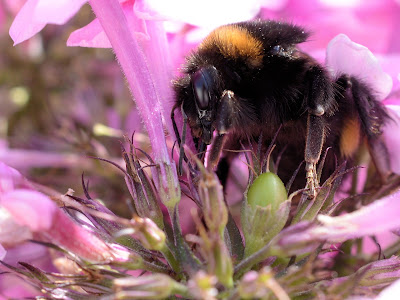Monday, September 30, 2013
little and large
Labels:
fungi
Saturday, September 28, 2013
a tissue of life
this little white drab daisy like flower is sneezewort. It is odd how something quite common like this can pass one by. Apparently the smell of it can make a man (and presumably a woman) sneeze. It was widely used to treat toothache, and blocked noses. Its leaves have a biting hot taste and have been used in salads. Found in Ged's fields at Bridestowe yesterday during a very pleasant walk, and lunch at the excellent White Hart Inn (see link) who have an enormous Great Dane puppy which put the fear of dogs into Spot.
Labels:
flora
Sunday, September 22, 2013
we'll ring you
Not all of our red telephone boxes have been removed, and some have been pressed into new life. Not sure that there will be a riot in Latchley any time soon.
Saturday, September 21, 2013
Monday, September 16, 2013
a strange looking bumblebee, which, even with the help of the Natural History Museum site (see link), I can't identify. It is probably a variant of something common. Only last night we were talking about grey wagtails, and lo and behold there was a small flock of them patrolling on the Inny this morning (the barely visible smudge of yellow on the rocks)
.
Labels:
birds,
Inny valley,
insect life
Friday, September 13, 2013
Thursday, September 12, 2013
the spirit of Max
After a long and slow decline, and a rapid turn for the worse this last few days, Max was put quietly to sleep today.
He was 15 and a bit. He loved being chased by other dogs but often couldn't find anyone to chase him so took up endlessly exploring the garden around the house. He hated water, men with flat hats, and any mention of any part of his anatomy. He was epileptic and needed treatment throughout his life. He wanted to learn but was incapable of instruction. So, having lived all his life here he has been buried next to a new walnut tree along side his best canine mates Cassie and Sophie.
He was 15 and a bit. He loved being chased by other dogs but often couldn't find anyone to chase him so took up endlessly exploring the garden around the house. He hated water, men with flat hats, and any mention of any part of his anatomy. He was epileptic and needed treatment throughout his life. He wanted to learn but was incapable of instruction. So, having lived all his life here he has been buried next to a new walnut tree along side his best canine mates Cassie and Sophie.
Farewell, old friend.
flower by Harriet Edwards
Friday, September 06, 2013
nectar robbing
Evidence of bumblebee theft, the lower part of the petal tube of garden phlox has been stripped away allowing easy access to the nectar.
Labels:
insect life
Wednesday, September 04, 2013
garden flocks
While I watched a sparrowhawk being mobbed by martins today as it hovered over the garden looking for sparrows, and a humming bird moth on the garden phlox something else caught my eye. Large bumblebees kept on disappearing into the heads of garden phlox (see top photo). On closer inspection it transpired that the bees were feeding from the base of the flower, between sepal and petal tube (see lower photo) rather than from the flower heads themselves. Is this common? I haven't found a reference to this behaviour on some brief internet searches. It would seem to negate the normal method of pollination.
PS I have found a reference now to this behaviour, it is called nectar robbing (see link). The reason it did not come up at first is that this site does not mention phlox. Looking at the flower one can see it has a very long petal tube, and I guess these bumblebees cannot reach the nectar at the bottom, so have to drill a hole in the petal tube... fascinating.
Labels:
flora,
insect life
Monday, September 02, 2013
Collies can swim
Photographic proof that some collies can swim! Meg will do anything to get hold of a stick before Harriet and Spot. Most collies we know won't even get their toes wet.
Labels:
dogs
Sunday, September 01, 2013
15 in one day 2
It was all getting a bit crowded. Bramble and knapweed have almost stopped flowering, and the meadows are full of devil's bit scabeous. The patches of scabeous were covered with a variety of pollinators getting their last top ups of the summer, drunk with nectar they were very docile allowing this sumptuous aerial view of a peacock.
Labels:
butterflies,
Inny valley
15 in one day
We saw 15 species of butterfly today on our walk along the Inny, including several more clouded yellows. They always close their wings at rest, but the top picture shows quite clearly the black edging on the upper surface of the wings of these distinctive butterflies when seen on the wing.
Labels:
butterflies,
Inny valley
Subscribe to:
Posts (Atom)





















